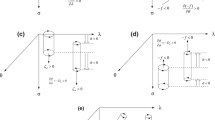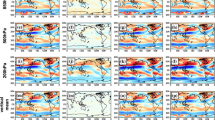Abstract
In order to study the interactions between the atmospheric circulations at the middle-high and low latitudes from the global perspective, the authors proposed the mathematical definition of three-pattern circulations, i.e., horizontal, meridional and zonal circulations with which the actual atmospheric circulation is expanded. This novel decomposition method is proved to accurately describe the actual atmospheric circulation dynamics. The authors used the NCEP/NCAR reanalysis data to calculate the climate characteristics of those three-pattern circulations, and found that the decomposition model agreed with the observed results. Further dynamical analysis indicates that the decomposition model is more accurate to capture the major features of global three dimensional atmospheric motions, compared to the traditional definitions of Rossby wave, Hadley circulation and Walker circulation. The decomposition model for the first time realized the decomposition of global atmospheric circulation using three orthogonal circulations within the horizontal, meridional and zonal planes, offering new opportunities to study the large-scale interactions between the middle-high latitudes and low latitudes circulations.






Similar content being viewed by others
Change history
01 March 2017
An erratum to this article has been published.
References
Bayr T, Dommenget D, Martin T, Power SB (2014) The eastward shift of the Walker Circulation in response to global warming and its relationship to ENSO variability. Clim Dyn. doi:10.1007/s00382-014-2091-y
Bowman KP, Cohen PJ (1997) Interhemispheric exchange by seasonal modulation of the Hadley circulation. J Atmos Sci 54:2045–2059. doi:10.1175/15200469(1997)054<2045:IEBSMO>2.0.CO;2
Charney JG (1947) The dynamics of long waves in a baroclinic westerly current. J Meteorol 4:136–162. doi:10.1175/1520-0469(1947)004<0136:TDOLWI>2.0.CO;2
Dima IM, Wallace JM (2003) On the seasonality of the Hadley cell. J Atmos Sci 60:1522–1527. doi:10.1175/1520-0469(2003)060<1522:OTSOTH>2.0.CO;2
Ding Q, Wang B, Wallace JM, Branstator G (2011) Tropical-extratropical teleconnections in boreal summer: observed interannual variability. J Clim 24:1878–1896. doi:10.1175/2011JCLI3621.1
Ferranti L, Palmer TN, Molteni F, Klinker E (1990) Tropical-extratropical interaction associated with the 30–60 day oscillation and its impact on medium and extended range prediction. J Atmos Sci 47:2177–2199. doi:10.1175/1520-0469(1990)047<2177:TEIAWT>2.0.CO;2
Gu D, Philander SGH (1997) Interdecadal climate fluctuations that depend on exchanges between the tropics and extratropics. Science 275:805–807. doi:10.1126/science.275.5301.805
Hartmann DL (1994) Global physical climatology. Academic Press, Waltham
Holton JR (2004) Synoptic-scale motions I: quasi-geostrophic analysis. In: Cynar F (ed) An introduction to dynamic meteorology, 4th edn. Elsevier Academic Press, Amsterdam, pp 139–176
Hu S (2006) The three-dimensional expansion of global atmospheric circumfluence and characteristic analyze of atmospheric vertical motion. Dissertation, LanZhou University (in Chinese)
Hu S (2008) Connection between the short period evolution structure and vertical motion of the subtropical high pressure in July 1998. J Lanzhou Univ 44:28–32 (in Chinese)
Julian PR, Chervin RM (1978) A study of the Southern Oscillation and Walker Circulation phenomenon. Mon Weather Rev 106:1433–1451. doi:10.1175/1520-0493(1978)106<1433:ASOTSO>2.0.CO;2
Kiladis GN, Feldstein SB (1994) Rossby wave propagation into the tropics in two GFDL general circulation models. Clim Dyn 9:245–252. doi:10.1007/BF00208256
Kousky VE, Kagano MT, Cavalcanti IFA (1984) A review of the Southern Oscillation: oceanic-atmospheric circulation changes and related rainfall anomalies. Tellus A 36:490504. doi:10.1111/j.1600-0870.1984.tb00264.x
Lau WKM, Waliser DE, Roundy PE (2012) Tropical-extratropical interactions, intraseasonal variability in the atmosphere-ocean climate system. Springer, Berlin
Liu Z, Yang H (2003) Extratropical control of tropical climate, the atmospheric bridge and oceanic tunnel. Geophys Res Lett 30:1230. doi:10.1029/2002GL016492
Liu H, Hu S, Xu M, Chou J (2008) Three-dimensional decomposition method of global atmospheric circulation. Sci China Ser D 51:386–402. doi:10.1007/s11430-008-0020-9
Oort AH, Peixóto JP (1983) Global angular momentum and energy balance requirements from observations. Adv Geophys 25:355–490. doi:10.1016/S0065-2687(08)60177-6
Oort AH, Yienger JJ (1996) Observed interannual variability in the Hadley circulation and its connection to ENSO. J Clim 9:2751–2767. doi:10.1175/1520-0442(1996)009<2751:Oivith>2.0.Co;2
Palmén E, Alaka MA (1952) On the budget of angular momentum in the zone between equator and 30°N. Tellus 4:324–331. doi:10.1111/j.2153-3490.1952.tb01020.x
Rossby CG (1939) Relation between variations in the intensity of the zonal circulation of the atmosphere and the displacements of the semi-permanent centers of action. J Mar Res 2:38–55
Tao Z, Zhou X, Zheng Y (2012) Theoretical basis of weather forecasting: quasi-geostrophic theory summary and operational applications. Adv Meteorol Sci Technol 2:6–16 (in Chinese)
Taylor ME (1999) Partial differential equations I: basic theory. Beijing World Publishing Corporation, Beijing, pp 344–350
Trenberth KE, Solomon A (1994) The global heat balance: heat transports in the atmosphere and ocean. Clim Dyn 10:107–134. doi:10.1007/BF00210625
Xu M (2001) Study on the three dimensional decomposition of large scale circulation and its dynamical feature. Dissertation, LanZhou University (in Chinese)
Yu B, Boer GJ (2002) The roles of radiation and dynamical processes in the El Nino-like response to global warming. Clim Dyn 19:539–553. doi:10.1007/s-00382-002-0244-x
Yu B, Zwiers FW (2010) Changes in equatorial atmospheric zonal circulations in recent decades. Geophys Res Lett 37:L05701. doi:10.1029/2009GL042071
Zhou X, Wang X, Tao Z (2013) Review and discussion of some basic problems of the quasi-geostrophic theory. Meteorol Mon 39:401–409 (in Chinese)
Acknowledgments
This work was supported by the National Natural Science Foundation of China (40805034 and 41475068), the Special Scientific Research Project for Public Interest (GYHY201206009) and the Fundamental Research Funds for the Central Universities of China (lzujbky-2012-13).
Author information
Authors and Affiliations
Corresponding author
Additional information
An erratum to this article is available at https://doi.org/10.1007/s00382-017-3554-8.
Appendix: The proof of Theorem 2
Appendix: The proof of Theorem 2
1.1 Sufficient conditions
If Eq. (3.5) holds, i.e., \(\nabla \cdot \vec{A} = 0\), the stream function vector \(\vec{A} = H\vec{i} + W\vec{j} + R\vec{k}\) satisfies
from Definition 1. We need to prove that Eq. (6.1) will lead to the conclusion that a zero velocity field can only be decomposed into three zero velocity fields, under the boundary conditions of \(H = W = 0,\frac{\partial R}{\partial \sigma } = 0\) if \(\sigma = 1\). In order to prove this, we apply vertical vorticity operation onto both sides of the first equation in Eq. (6.1) using the definition of 3D vorticity vector in Eq. (2.5), and fitting the second equation in Eq. (6.1) into it. We then obtain
Using the condition of Theorem 2, we have
where \(\varOmega = S^{2} \times [0,1]\), \(S^{2} = \{ ( (\lambda ,\theta )|0 \le \lambda \le 2\pi ,0 \le \theta \le \pi \}\) is the surface of unit sphere, \(\partial \varOmega\) is the boundary of \(\varOmega\), i.e., the surface of a unit sphere, and \(n\) is the unit outer normal vector of \(\partial \varOmega\). The operator \(\varDelta\) is the 3D Laplacian in the spherical \(\sigma\)-coordinate system:
We know from the existing mathematical theorems (Taylor 1999) that the solution of Eq. (6.2) is existed and unique up to a constant. When \(\vec{V}^{{\prime }} \equiv 0\) (\(u^{{\prime }} ,v^{{\prime }}\) are zeros), the stream function \(R\) is a constant, and we must have \(\vec{V}_{R}^{{\prime }} \equiv 0\). Using Eq. (6.1) and the conditions in Theorem 2, we have
Thus, \(W = \int_{1}^{\sigma } {\left( {\frac{\partial R}{\partial \theta } + u^{{\prime }} } \right)d\sigma }\) and \(H = \int_{1}^{\sigma } {\left( {\frac{1}{\sin \theta }\frac{\partial R}{\partial \lambda } - v^{{\prime }} } \right)d\sigma }\) uniquely exist. When \(\vec{V}^{{\prime }} \equiv 0\) (\(u^{{\prime }} ,v^{{\prime }}\) are zeros), \(R\) is a constant, and thus the stream function \(H,W\) are zeros, leading to \(\vec{V}_{H}^{{\prime }} \equiv \vec{V}_{W}^{{\prime }} \equiv 0\). This proves that Eq. (3.5) guarantees the three-pattern decomposition of global atmospheric circulation uniquely exists.
1.2 Necessary condition
We will approach to the proof by contradiction. According to Definition 1 and the conditions of Theorem 1 and Theorem 2, we can assume that the three-pattern decomposition of global atmospheric circulation uniquely exists, i.e., for given \(\vec{V}^{{\prime }} = \vec{i}u^{{\prime }} + \vec{j}v^{{\prime }} + \vec{k}\dot{\sigma }\) and \(\nabla \cdot \vec{V}^{{\prime }} = 0\) there exists a unique stream function vector \(\vec{A} = H\vec{i} + W\vec{j} + R\vec{k}\) satisfying
-
1.
\(- \nabla \times \vec{A} = \vec{V}^{{\prime }}\), i.e., \(\vec{V}_{H}^{{\prime }} + \vec{V}_{W}^{{\prime }} + \vec{V}_{R}^{{\prime }} = \vec{V}^{{\prime }}\);
-
2.
\(\vec{V}^{{\prime }} \equiv 0\) will lead to \(\vec{V}_{H}^{{\prime }} \equiv \vec{V}_{W}^{{\prime }} \equiv \vec{V}_{R}^{{\prime }} \equiv 0\);
we must have \(\nabla \cdot \vec{A} = 0\). This because, otherwise, if we assume that \(\nabla \cdot \vec{A} = D \ne 0\), then \(\vec{A}\) must satisfy
According to theories of fluid dynamics, \(\vec{A}\) can be uniquely decomposed into \(\vec{A} = \vec{A}_{1} + \vec{A}_{2}\), where \(\vec{A}_{1} = H_{1} \vec{i} + W_{1} \vec{j} + R_{1} \vec{k}\) and \(\vec{A}_{2} = H_{2} \vec{i} + W_{2} \vec{j} + R_{2} \vec{k}\) are satisfying
Furthermore, according to the conditions of Theorem 2, we have
when \(\sigma = 1\). Applying the above discussions about the sufficient conditions to Eq. (6.6), we know that \(\vec{A}_{1}\) uniquely exists up to a constant when \(\vec{V}^{{\prime }} \equiv 0\) (\(u^{{\prime }} ,v^{{\prime }}\) are zeros), and we then must have \(\vec{{V}_{H}}{_{1}^{{\prime }}} \equiv \vec{{V}_{W}}{_{1}^{{\prime }}} \equiv \vec{{V}_{R}}{_{1}^{{\prime }}} \equiv 0\). Since \(\nabla \times \vec{A}_{2} = 0\) in Eq. (6.7), there must exists a scalar function \(\varphi (\lambda ,\theta ,\sigma )\) such that
i.e.,
Thus
Using the boundary conditions of Eqs. (6.8) and (6.9), we have
when \(\sigma = 1\). If we denote \(\tau = \tau_{1} \vec{i} + \tau_{2} \vec{j}\) the horizontal tangent of any point on \(\partial \varOmega\), we obtain the direction derivative of the function \(\varphi\) along \(\tau\)
from the definition of direction derivative and using Eq. (6.11). From Eqs. (6.10) and (6.12) we know that the scalar function \(\varphi (\lambda ,\theta ,\sigma )\) satisfies
Note that \(\frac{\partial \varphi }{\partial \tau }|_{\partial \varOmega } = 0\) is equivalent to \(\varphi |_{\partial \varOmega } = c\), where \(c\) is a constant. In other words, the zero direction derivative of \(\varphi\) along any horizontal tangent \(\tau\) on \(\partial \varOmega\) will lead to the fact that \(\varphi\) is a constant on the sphere surface \(\partial \varOmega\). Thus, Eq. (6.13) is equivalent to
Apparently, the solution of Eq. (6.14) is uniquely existed and the gradient \(\nabla \varphi = \vec{A}_{2}\) for \(\varphi\) satisfying Eq. (6.14) is not a vector constant (otherwise we must have \(\nabla \cdot \vec{A}_{2} = \varDelta \varphi = D \equiv 0\)). We then have\(\nabla \times \vec{A}_{2} = \nabla \times \nabla \varphi = 0,\) i.e.,
Using Eq. (6.6) we have \(- \nabla \times \vec{A} = - \nabla \times (\vec{A}_{1} + \vec{A}_{2} ) = - \nabla \times \vec{A}_{1} = \vec{V}^{{\prime }} ,\) which can be expressed as
and
From Eqs. (6.15) to (6.17) we know that when \(\vec{V}^{{\prime }} \equiv 0,\) a zero velocity field will be decomposed into three nonzero velocity fields, a contradiction to the definition of appropriate circulation decomposition. The hypothesis of \(\nabla \cdot \vec{A} = D \ne 0\) does not hold, we must have \(\nabla \cdot \vec{A} = 0\). The proof is completed.
In the above proof, from Eqs. (6.15) to (6.17) we note that the vector \(\vec{A}_{2}\) has no contribution to the original velocity field \(\vec{V}\), but it contributes to the decomposed velocity fields \(\vec{V}_{H} ,\vec{V}_{W} ,\vec{V}_{R}\). The existence of \(\vec{A}_{2}\) not only gives non-unique decomposition, but also generates inconsistent decomposition results, i.e., zero velocity is decomposed into two nonzero velocity with equal magnitude and opposite direction. The condition of \(\nabla \cdot \vec{A} = 0\) in the theorems ensures that \(\vec{A}_{2} \equiv 0\), and thus leads to the existence and uniqueness of our three-pattern decomposition of global atmospheric circulation.
Rights and permissions
About this article
Cite this article
Hu, S., Chou, J. & Cheng, J. Three-pattern decomposition of global atmospheric circulation: part I—decomposition model and theorems. Clim Dyn 50, 2355–2368 (2018). https://doi.org/10.1007/s00382-015-2818-4
Received:
Accepted:
Published:
Issue Date:
DOI: https://doi.org/10.1007/s00382-015-2818-4




